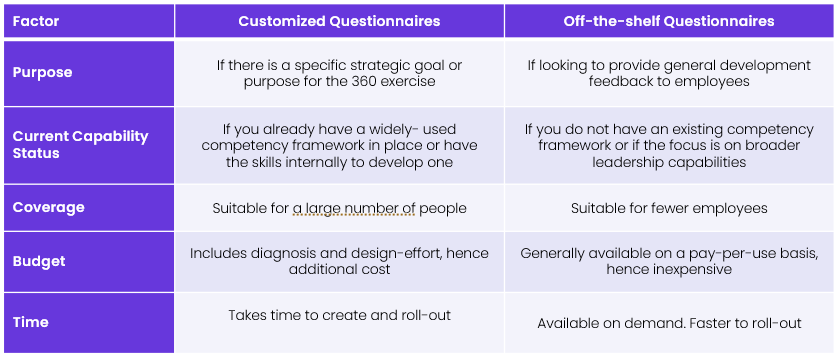A practical guide to planning and executing impactful 360-degree feedback surveys for leadership and talent development.

360 Degree feedback surveys can be a very powerful tool to get detailed and well-rounded inputs from an employee’s seniors, peers, juniors and external stakeholders. These inputs can be about the employee’s skills and performance or other aspects like competencies and values. 360 feedback surveys are trusted by organizations across the world as an effective tool for facilitating employee performance and development.
Here are a few contexts in which 360 feedback surveys can be used effectively as a tool:
Enabling managers and senior leaders in the Organization to receive feedback on managerial competencies and use this feedback to create their personal development plans.
Conduct 360 feedback process for large pools of employees to get more detailed understanding of collective strengths and development areas. The inputs are typically used as one of the inputs into the talent review or succession planning process using a framework like 9-box grid.
Conduct 360 feedback process for participants at the start and/or end of a Development Program to understand their progress on key competencies covered in the Program.
While 360 feedback survey is a powerful tool, conducting effective 360 surveys require careful planning and preparations. Elements of the Survey like Questionnaire design and post-Survey activities require careful thinking. At the same time, since 360 surveys involve many people across the Organization, a structured communication plan becomes critical to ensure that all stakeholders are clear about the different aspects of the Process.
This brief Guide explores key issues and questions one needs to think through while planning a 360-feedback survey intervention. Our focus has been on practical issues and considerations related to administration of such interventions rather than topics like how to design a Survey questionnaire. We hope that you find the Guide useful in planning your own Intervention.
A well designed 360-Degree feedback survey can definitely lead to enhancement of business and potential, but documented studies have shown that a poorly designed feedback can backfire, leading to distrust and disengagement in the employees. To ensure that your 360 feedback survey intervention delivers the right outcomes, make sure you consider the purpose and context of the Survey even before starting the process.
There are two broad questions you may want to think about.
Different stakeholders in the Organization may expect the 360-Degree feedback survey to serve different purposes. For example, the Business Head may be looking to use the process to highlight poor performers and/or the leadership team of your Organization may be expecting that the process will be tied back to promotions or rewards. A defined, clear reason behind running a 360 survey along with a structured plan on how to best use the results, is a pre-requisite towards conducting an effective 360 survey process.
Before you start the process of deploying a 360 feedback survey, it is vital that you consult all stakeholders – leadership team, managers, and employees. Make sure you document the final set of objectives since it will help in communicating the same to all participants and respondents later.
Organizational culture and context determine whether employees will be able to or be willing to give honest feedback to each other. If your organization is currently going through major changes or financial difficulties, it may prove difficult for you to get employees to open up and share honest feedback. Also, it is difficult for employees to give honest feedback to each other when the outcome of the feedback process can be used to decide on promotions or rewards.
In our experience, 360 feedback surveys yield the best results when used as an instrument to support employee development and not when they are used to decide rewards and recognition. Self-development is a journey which starts with self-awareness. A well- designed and correctly used 360 survey will always be the right way to start this journey with
Online platforms like Elemetrik have made conducting 360-Degree feedback surveys much easier. Many of the operational steps in conducting the Survey – sending email reminders to respondents and analyzing and reporting the results- are mostly automated.
However, we have captured below 5 key elements that one should work on prior to going live with the Surveys.
360-Degree feedback surveys typically involve a large number of employees with sometimes 10+ employees providing feedback to each participant. Both providing and receiving feedback can be difficult for most people. Designing a clear orientation process can help you make sure you help all stakeholders understand the different stages in the entire Survey process and answer their concerns, especially around anonymity and confidentiality and how the Reports will be used.
The Survey Questionnaire is one of the most components of any 360-Degree feedback Survey process. Selecting or designing a Questionnaire requires you to consider many factors covered in the next section. However, once your Questionnaire is ready, make sure you spend sufficient time taking key senior stakeholders through the design of the Questionnaire and the Report. Understanding and addressing their inputs and concerns can help you win their support and manage the post-Survey process effectively.
Running an online 360 survey well means getting many things right. Has the link been whitelisted? Have you uploaded the right questionnaire? Are participants seeing the right instructions on opening the link? One effective way to get everything right is to run a set of pilot surveys. Configure everything exactly as in the final Survey and get 7-10 of your colleagues to respond to the Survey. Give them a checklist of things to look for and check-in with them to confirm whether everything worked correctly for them. This will help you catch issues before you release the Survey to a large group of people.
360-Degree Feedback Reports are, by their very nature, sensitive documents. If you are running the Survey for a large group of people, make sure you have a clear plan around handling the Report. Some of the questions you may want to think through are:
Getting respondents to your Survey can be one of the most difficult part of the Survey process. With their day-to-day taking up most of their time and attention, you need to create a well-crafted communication plan to make sure your respondents are aware about the Intervention and prioritize the survey invitations once they receive it. Make sure you build up anticipation around the Survey prior to launch and you send regular reminders to people with pending surveys in their accounts
The dilemma that most process owners face with a 360-feedback survey is whether to go for one of the many off-the-shelf questionnaires readily available or create a questionnaire customized to their requirements. Most believe that customized questionnaires are more effective than the off-the-shelf ones.
However, the trade-off is not so simple and depends on factors as outlined below:

Off-the-shelf questionnaire should be used when the survey is being conducted for a select group of employees or the leadership team as part of the development process. However, if you are conducting the survey as part of a strategic initiative or as a wider organization-wide program, then we recommend that you get help in developing a customized questionnaire for the process.
Getting in the responses and closing the Survey does not mean that the Intervention is over. As the Process Owner, you need to ensure that participants go through their individual reports and are able to understand and take development action based on their Reports.
Here is a quick checklist of actions you may want to take after closing the Surveys.
Apart from the actions related to the online platform, conducting a successfully 360-Degree feedback survey intervention requires one to work through a range of activities to set the right context, ensure sufficient participation and achieve the desired outcomes post the Survey. This requires careful planning and an orientation towards aligning all stakeholders and addressing their concerns and issues. We hope this Guide helps you, as process owners of a 360-Degree feedback intervention, to plan and organize your Intervention successfully.
Schedule a call to activate your account — and start using the tools right away.
© 2025 Elemetrik. All rights reserved.